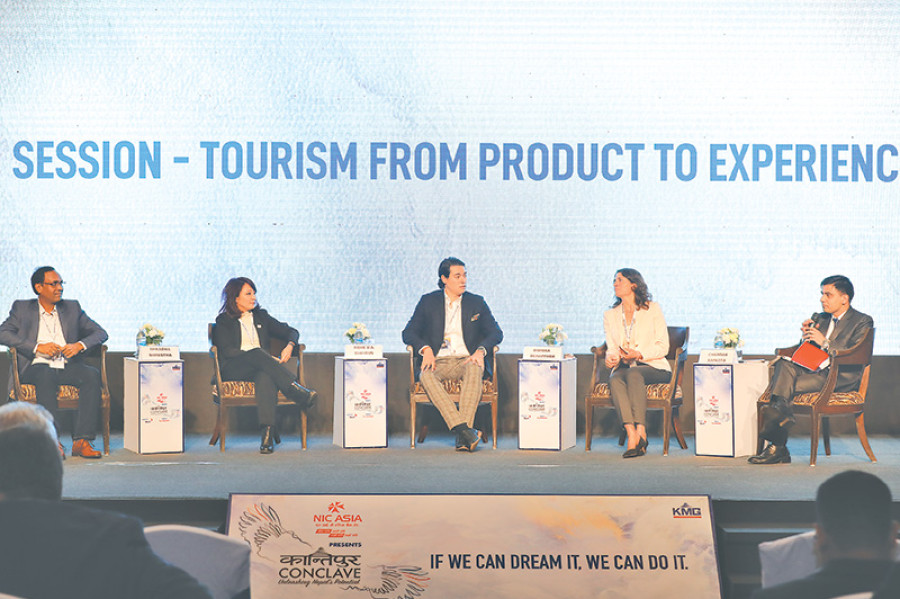Money
Experts weigh pros and cons of mass tourism
Nepal’s natural beauty, diverse wildlife and wealth of pilgrimage sites can be a huge draw in the global tourism market, and this should be the marketing mantra for the Visit Nepal campaign version 3.0. The third edition of the promotion slated for 2020 has the goal of attracting 2 million foreign tourists, hospitality industry analysts said at Monday’s Kantipur Conclave.
Sangam Prasain
Nepal’s natural beauty, diverse wildlife and wealth of pilgrimage sites can be a huge draw in the global tourism market, and this should be the marketing mantra for the Visit Nepal campaign version 3.0. The third edition of the promotion slated for 2020 has the goal of attracting 2 million foreign tourists, hospitality industry analysts said at Monday’s Kantipur Conclave.
Speaking on the topic ‘Tourism: From Product to Experience’ on the second day of the conference, panelists said one concern was being discussed in hushed tones: Will the country’s poor infrastructure allow the industry to reach this ambitious goal? Insights on Nepal’s tourism goal in 2020 were divided. From a business perspective, the panelists said the 2-million goal was attainable; but from the environment viewpoint, it was just like bringing an unwanted crowd.
“The 2-million figure scares me,” said Monika Schaffner, Integrative Geographer, Connecting Spaces. “I don’t think Nepal will be able to accommodate 2 million foreign tourists in a sustainable way.” She said that nature and heritage should be preserved from the spread of infrastructure development and thoughtless development activities.
“Having observed development in Nepal for almost a decade, though developing infrastructure is important for economic development, it also threatens to disrupt the experience of nature.” Schaffner said more important was the value. For example, in Annapurna and Upper Mustang, road connectivity may have brought development, but it has destroyed a lot which cannot be recovered. “Once we lose them, they cannot come back.” Schaffner thinks lower impact means higher value travellers, and that Nepal needs to think on this wisely.
Shradha Shrestha, manager, brand development and tourism promotion at the Nepal Tourism Board, said that Nepal’s tourism is mature enough to host 2 million foreign tourists. “Our existing hotels and lodges can accommodate 2.5 million tourists annually.” But there are certain infrastructure bottlenecks like roads and airports, she said. “We are optimistic that Nepal’s second international airport in Bhairahawa will be completed by September this year, and the upgradation of Tribhuvan International Airport will be completed before the Visit Nepal campaign.”
Rene Vijay Shrestha, executive director, Dwarika’s Group of Hotels and Resorts, questioned whether Nepal’s infrastructure was ready to host 2 million foreign visitors. “We all know, the luxury segment tourism is moving to Nepal. We need to tap this opportunity by giving the visitors a different type of experience,” he said. “We have so much untapped potential. The only thing is that we have not promoted them in the right way.” He added that value in tourism was obviously a big thing, but Nepal needed all types of tourists.
Anil Goel, chief technology officer of OYO Rooms, commonly known as OYO, India’s largest hospitality company consisting mainly of budget hotels, said they were here to offer the right mix of location and quality. “There is infinite demand in Nepal. We came to Nepal two years ago; and now, we offer more than 2,000 rooms. If you focus on providing good quality experience, there is a possibility of expansion.” In Nepal, no place is off-limits to tourism.
Moderator of the panel economist Chandan Sapkota said the tourism industry should grow without infrastructure restrictions. Every dollar spent by foreign visitors has a multiplier effect on the country’s economy.
The Visit Nepal campaign had actually been planned for 2018, but due to the slow pace of road and airport upgradation and heritage restoration projects, it was postponed to 2020. The first national tourism campaign was launched in 1998 when Nepal hosted 463,684 visitors, representing a growth of 10 percent year-on-year. The campaign was launched to help the tourism industry recover from the disastrous decade-long Maoist insurgency (1996-2006).
In 2011, the government launched another Nepal Tourism Year campaign with the goal of bringing 1 million tourists. Although actual arrivals fell short of the target, 736,215 tourists visited the country, representing a growth of 22 percent over the previous year.
Tourism, one of the major contributors to Nepal’s Gross Domestic Product, was severely affected after the earthquakes of 2015 as potential travellers stayed away. That year, tourist numbers plummeted to 539,000, a loss of almost a third. Before the earthquake in 2014, Nepal had received 790,000 tourists. Arrivals crossed the coveted one-million mark for the first time in 2018 with 1.17 million foreign tourists streaming into the country.




 18.12°C Kathmandu
18.12°C Kathmandu













%20(1).jpg&w=300&height=200)
